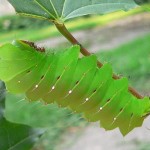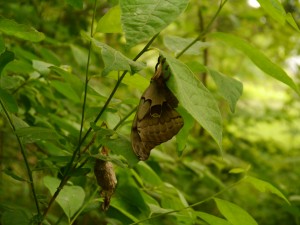by Barb Elliot
When I was a ten year old kid I “saved” a Polyphemus moth my father had almost accidentally killed while pruning our hedge. Actually, I didn’t save it—in truth, quite the opposite. I captured it and put it into a collecting jar. After it died I mounted and framed it. Enamored with butterflies and moths, I then hung it in my bedroom along with the rest of my collection. Over the years I have displayed this beautiful, six-inch moth in my various homes. However, I never saw one in the wild again until this spring – more than 50 years later.
On May 20th, a spectacular male Polyphemus moth just like that first one emerged from a cocoon in my yard. I had discovered the large cocoon hanging from a Spicebush twig in early March. I couldn’t tell what type of moth might be overwintering in the cocoon, but I checked it often, hoping to see what would emerge.
When the time came, I almost missed it because it hung several inches from the cocoon, which appeared to be intact except for a small hole in the top. As the moth hung among the leaves, only the under wings, which look like dead leaves, were visible. I would have liked to see the more striking upper sides of the wings, but did not disturb it for a better look. This moth was to remain completely free — and in fact it was gone by the next day.
It likely flew off that night in hot pursuit of a female, using its large, feathery antenna to detect the powerful sex hormone scents (pheromones) a female emits to attract a mate. Polyphemus males can detect and fly to females that are miles away. The moths survive for about a week, living only to mate and lay eggs. In fact, the adults don’t have mouthparts and can’t eat or drink.
A Polyphemus caterpillar, however, is an eating machine.
In the five to six weeks it takes until it is ready to pupate and spin its cocoon, it increases its weight by more than 10,000 times and grows to three inches long and ¾ inch in diameter. The caterpillar then wraps itself in a leaf and encases itself in silk thread spun from its mouth or it may crawl down and spin its cocoon on the ground. A cocoon wrapped in a leaf may stay on the tree or shrub all winter as “mine” did, or it may fall to the ground in the autumn. This is an important reason not to rake up the leaves that fall under your trees and shrubs.
As a result of their nocturnal habits and since so few make it to adulthood, not many of us ever get to see these beautiful creatures. Birds and mammals search out the protein-rich caterpillars, and few caterpillars escape the many parasites that prey on them. If you provide host plants that the caterpillars eat, you can increase your chances of seeing one and help to increase their chances of survival. Polyphemus moth caterpillars eat the leaves of a variety of native trees, including Oaks (Quercus), Maple (Acer), Birches (Betula), Hickories (Carya), Walnut (Juglans), Black Cherry (Prunus serotina), and American Elm (Ulmus americana). I’m not sure which of these plants “my” caterpillar ate, as I have five of these species in my yard.
The Polyphemus moth is in the family of large showy silk moths native to southeastern Pennsylvania. Others species include the Cecropia (the largest moth in North America), Luna, Io, Imperial, Promethea, Tuliptree, Rosy Maple, and Royal Walnut Moth. These moths also eat a variety of native trees and shrubs that would make great additions to a yard.
One last thing you can do to help the Polyphemus and other moths survive and reproduce successfully is to keep outdoor lights turned off as much as possible. Any lights at night can “capture” moths, interrupt their search for mates, exhaust them, and make them easy targets for predators.





